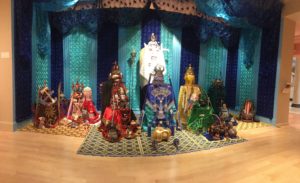
Background:
Santeria or Regla de Ocha is an African-Cuban religion that is part of a group of religions that are referred to as part of the African Diaspora. The religious practices of many different parts of Sub-Saharan Africa were brought over to the Americas by enslaved African people from the 1500s to the 1800s. The pantheon of many gods from many different religions began to take shape as those who were enslaved made an effort to keep their heritage and religious traditions alive despite the lack of any rights. The many gods have roots in Modern day Nigeria, Angola, and Congo. The mixture of religions and loss of some deities is due to loss of ability to practice a religion that is focused on material objects and rituals because of enslavement and social ostracization.
Cuba’s diasporic religion is known as Regla de Ocha, Santeria, or Lucumi. The religion incorporates religious practices from Africa, Christianity, and those of the indigenous people of Cuba. Most of the Religion’s practitioners are also baptized members of the Roman Catholic church which is due to the Spanish influence over the enslaved people who were brought over and the subsequent forced conversion to Christianity by the Spanish empire.
Catholic saints each have a corresponding orisha that represents them in Santeria. Yemaya the goddess of the sea and the Virgin Mary are worshipped as one due to the two religious icons similarities for what they represent. Due to the almost immediate integration of the saints into the religion the practitioners of the religion were then able to practice the religion. This was because the way the rituals and worship were done it appeared as though the Catholic saints were being worshipped. Although practices were still confusing and suspect to those who didn’t practice it due to the saints being revered more than jesus. This resulted in the name Santeria meaning worship of saints. Despite it confusing the authorities, it wasn’t banned which allowed the religion to exist in a place where it otherwise could have been considered witchcraft or even blasphemy.
The Cuban Revolution of 1959 caused the religion to spread as the new government outlawed all religion and many practitioners escaped the country and came to the United States. Then in 1974 the Church of Lucumi Babalau Aye was created in Hialeah Florida as the first official Santeria worship site in the United States. Most of the practitioners who escaped Cuba during the revolution escaped to Florida due to its close proximity to the island nation and as a result formed a Cuban community in Florida.
One of the most important parts of Regla de Ocha is animal sacrifice. The animal being sacrificed is then used in some way and is always eaten at some point either during or after the ritual. Drinking the blood of the animal that is sacrificed is often also practiced during the ritual to cleanse the spirit of the person consuming it. In Hialeah florida in 1987 the city outlawed animal sacrifice which caused the priest of the church of the Lucumi Babalau Aye to take the city to court. The trial eventually made it all the way up the the Supreme Court which ruled against the city in 1993 and declared the law unconstitutional because it went against the First Amendment’s free practice of religion clause.
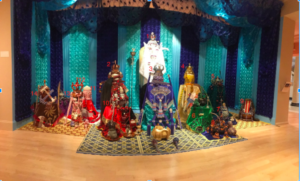
Orishas
The following orishas are the ones present in the altars. These are not the only orishas found in the world.
Agallu (14)
Agallu is the deity that is represented by nature and the volcanoes. He is the heat that is said to be present in all beings. He represents the lava and the magna in the center of the earth and all of the effects which come from that, such as earthquakes. He is the ferryman of the mortal soul, helping people cross the river. His color is burgundy and dark reds and his number is 9.
Babalu Aye (13)
Babalu is the orisha of the sun and disease. He is very powerful and often feared because he has been know to spread diseases. He is found in places similar to hospitals and also the desert. He is said to be happy because he has the ability to cure diseases and often condemns people to death because they are very sick or in a great deal of pain. His colors are brown and earthy tones and his number is 17.
Chango (12)
Chango is the orisha of thunder and the thunder bolt or any loud hard sound that is coming from the sky. Chango rides his horse around to serve justice with his extreme physical form. He has red and white as his colors and is usually kept in a wooden vessel and his number is 6. He is one to always dance and keep the festivals going. He is one of the more known orishas in santeria religion.
Inle (5)
Inle is the god of healing and personal health. Inle is a man with feminine features. He is said to be a humble man going to where he is needed helping the poor and weak. His colors are a blue, green, and yellow. He represents the people who are quite beings and love to help and nurture other people.
Obatala (1)
Obatala is the deity that is the ruler of all other deities. Obatala is both female and male and is one of the purest and wisest orishas. Obatala’s color is white and everything that is given to him and he is summoned to bring order and peace among the world. Obatala is associated with the number 8 and created humankind. Obatala has lots of paths that other deities follow.
Ochosi (8)
Ochosi is the orisha that lives in the woods and represents the hunt. He always has a bow and arrow and has great knowledge of the herbs and plants in the forest. He is also an orisha of justice and enforcement. All people who are in the law have Ochosi to protect them. He has the colors of blue, yellow, and green and his number are 3, 4, and 7.
Ochun (4)
Ochun is the deity of love and all things sweet. According to patakis or sacred stories, she is also the youngest because after the world was created there was a lack in love. Ochun put the two things in life that are worth living for. She rules over the rivers and offerings are often to a river. She inspires the conception of children but rarely is the one to look after them. She is said to be happy and have little cares. Her colors are yellow and gold and her number is 5 and multiples of 5.
Orisha Oco (9)
Orisha Oco or Oko is the god and father of the land. He is the one who helps farm and keeps crops fertile and harvested. He is also the judge of the orishas and makes sure to protect the females when there is an argument. He is also an orisha of fertility be it to crops and to people. He represent the hard working people and they worship him daily by offering things to the earth. His colors are pink and light blue and his number is 7.
Oggun (6)
Oggun or ogun is the deity of the woods and iron. He is the one who forges the tools for people and he is incharge of all things construction. He is always one step ahead of you ready to be the first one to protect you. His colors are green, red and purple and his main tool is the machete. He is one of the main gods in which animal worship is done for. His numbers are 3 and 7 and has many different paths or personalities: Alagwede (oldest) or Arere (secret of the metal).
Oya (2)
Oya is the goddess of winds and storms and brings wanted or unwanted change to humankind. She is one of the fiercest orishas and is the most fierce among the female orishas. She is the gaurd between life and death standing at the cemeteries. She is one of the few warrior orishas. Her movements are fast and violent and tornadoes are said to be the result of her dancing. Her colors are everything but black and is represented by 9.
Elegua(11)
Elegua is the orisha of the crossroads, he represents the beginning and end of life and the opening and closing of doors. He can be considered a trickster and should be honored properly in order to ensure he does not play a trick on you and improperly relay a message. Cigars are a popular item to leave on his altar. His colors are red and black and his number is 3. In Cuban Santeria Elegua’s “Saint’s day” occur on both January 6th and June 13th.
Olocun (7)
Olocun is orisha of both the living and the death. She lives at the bottom of the sea where humans can’t see unless they are dead. She is worshipped to benefit health, life pursuit and prosperity. She resides in a blue and white tureen in houses and has a compulsive temper. Her colors are blue and white and her numbers are 7 and 9. The offerings made to her are usually cast into the sea.
Yemeya (3)
Yemaya is one of the most powerful orishas and is the great mother who rules over the sea. She is as essential to life as water is because she represents water. She is fair minded and nurturing but when she is outraged she is fierce but forgiving. She is represented by anything that comes from the sea, shells, fishes and boats. She dances with grace at first but she gains speed and the rhythm of the wave show this movement. Her number is 7 and her colors are blue with white.
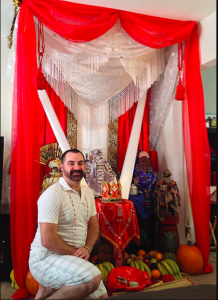
A reflection on studying religion from the perspective of altars and sacred objects
While studying religion, defining religion itself is the first step to understanding a specific religion. The study of religion can be approached from many different angles. Definitions, features, concepts, morals, and worship are all aspects of religion. Once the definitions of the specific religion’s components are defined, the religion can be analyzed.
Within the class, Altars of the Black Atlantic, the terminology had to first be defined. Most of us have never heard of the any of the Atlantic religion. Once we understood the basic division of the different Atlantic religions and learned the proper terms within the religions, we were able to participate in analyzing the religions. We were able to understand how religion played a role in the lives of those who worship it.
The first opportunity to analyze Atlantic religions came from reading how the religions were formed. We first looked at how Yoruba Religion originally formed in Africa and how it migrated to Cuba, Haiti, and Brazil via the African Diaspora. These religions are relatively new constructs compared to other religions. We were shown how religion is a manmade construct. We analyzed the conditions under which the Atlantic religions formed.
While studying the formation of religion we also studied why the religions formed. We saw that each religion maintains the similar aspect of preserving nostalgia. Religions that migrated from Africa try to maintain the African nostalgia and Yoruba works to maintain a connection with past ancestors.
We also analyzed the people who worship within the religion. The religion is practiced through worship The celebration of group identity and unity established community away from the original practice in Africa. Each practices a similar set of morals. While looking at the morals we were faced with the question on what is religion and what is lifestyle. The relics and altars used in the religion are the center of worship. We analyzed if constructing the altar is part of worship or if worship begins once the altar is constructed. Because the Afro-Atlantic religions have no written scripture, all that is learned on how to worship is passed down from one generation to the next. This allows the practice of worship to be left to the individual.
Altars are a large icon within Afro-Atlantic religion. Each Altar possess the same basic concepts, but they are personal to the one that constructed it. Altars are left to interpretation for onlookers of the religion, but the purpose of the altar is clear to the one that built it. Onlookers still have a clear view of how to pay respects to the altar and how to pray to it. The altars have a different purpose for each viewer. The basic concept of preserving African nostalgia and giving respect to ancestors is still present to each viewer. This is what creates a sense of community and what builds the religion.
Even though each religion has a similar framework to what defines it as religion, there are aspects that set each apart from the other. We analyzed the worship and icons within the religion, and the set of morals that drove the construction of the religion. Afro-Atlantic religion is set apart from the others because of the sense of nostalgia.

Layout
Birthday Altars are assembled in a particular way to show relationships between Orisha and to have them embody the altars. Orisha are drawn to objects that represent themselves, by having objects that connect to a particular Orisha that Orisha will be in a sense alive within that altar. The height of each altar symbolizes the hierarchy between the Orisha. Obatala, who is considered the creator, sits on the highest throne, while other royal Orisha like Yemoja, Oya, Inle, and Ochun sit on thrones lower than Obatala but higher than other Orisha due to their royalty. According to page 104 of “Asho Orisha (Clothing Of The Orisha): Material Culture As Religious Expression In Santeria” by Mary Ann Clark, “…Warriors (Eleggua, Ogun, Ochosi) are placed closest to the floor toward the front where they can act as sentinels guarding their fellow Orisha.” The Birthday Altar represents all the Orisha a priest has acquired throughout the years, the very first Orisha will be the center of the altar. This is confirmed by Clark on the same page used above, “The Orisha who are the mother and father of the celebrant have prominent positions elevated in the center of the room…” Soup tureens, which are present on each altar, stand in the center because they embody the Orisha through sacred objects placed inside and represent the “head”. Ceremonial necklaces are wrapped around the tureen because it is the head of the altar, just like a necklace would be around one’s neck. Food offerings are placed on individual thrones to meet the needs of each Orisha. Objects that represent a particular Orisha sit on that Orisha’s altar, “… each Orisha is surrounded by their particular tools and symbols…”, as described by Clark on page 104. The layout of the altars in a Birthday Altar allow the relationships between Orisha and the priest to be observed while also allowing the orisha to embody the altar through sacred objects in the tureens. The altar is also divided on each side by “cool” Orisha on the right and “hot” Orisha on the left. This is easily noticeable by the colors displayed on and around the various tureens. Being a very ordered religion, the layout of Santeria altars is meticulously planned, nothing is there without purpose.
Purpose:
A birthday altar is meant for the celebration of the day a priest or priestess was initiated, when a person is initiated it means that they add that god to their head and to the gods who have control over their life. The birthday celebration usually lasts for a seven day period but the biggest part of the celebration occurs on the day that the priest or priestess was actually initiated. This was all explained by Mary ann Clark in her thesis paper “Asho Orisha (Clothing of the Orisha): Material Culture As Religious Expression in Santeria”
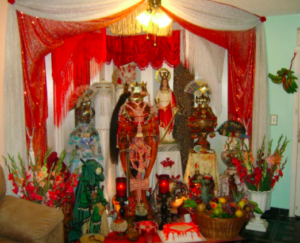
Most often these elaborate birthday altars are built by the priest or priestess whose anniversary of initiation is being celebrated with the help of their godchildren, godparents, and other friends and family who also participate in the religion. These altars very often take up an entire room to themselves or at least take up a large sectioned off portion of a room. All the walls and ceiling are covered in fabric to separate the area of worship for the Orisha and the rest of the house. We also know from our reading by David Brown, “Altar Making and Gift Exchange”, that there are priests and priestesses who build altars professionally and who see it as an artwork, so some priests may hire someone to come and help them to build their birthday altars if they want to do something very elaborate that they don’t believe that they can do without the help of an experienced altar builder.
According to Clark, on the first day of the celebration, the anniversary of the initiation, the Santera’s religious family comes to their house to celebrate. Once they enter the house they must go to where the birthday altar is located, whether that be in a spare room or in a sectioned off corner of a room, they must greet the Orisha. The guests greet the Orisha by prostrating themselves on a mat in front of the birthday altar. Offerings of money, different goods, or food specific to what the god or goddess likes are left at the altar by the godchildren of the host or hostess. Those members of the religious family who could not make it to the actual celebration can come and participate by coming by to worship the Orisha through bringing gifts and such by going to the santera’s house during their week of celebration and prostrating themselves at the birthday altar and congratulating them on the anniversary of initiation.
During the celebration when the religious family are at the home of the host or hostess there will often be either live drumming for the Orisha or recorded music that represents the Orisha specifically. All the guests who came to the celebration will be offered some of the food that was made and presented to the Orisha, and at the end of the night each of the guests will leave with many of the deserts and the fruits that were presented to the Orisha on the birthday altar so that all who came can be included in the ashe of the birthday celebration.
Objects
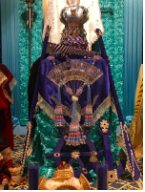
Yemeya goddess of the Sea
Crown- The Crown is light blue with light bronze metal accents. The metals are almost silver. The crown is covered with anchor ornaments.
Vase- The crown sits on the blue vase. The vase is covered with blue beads and have a staircase pattern. Some of the beads are white and the others are blue. The blue beads are the ones that make the pattern
Fly Whisk – the whip is made of dark black hairs. The handle of the whip is made of blue, red and white beads. The beads spiral along the handle.
Oars- two oars rest on each side of the altar. Both are covered with blue beads. The edges of the paddle are lined with white beans. The middle of the paddle also has white beans that follow the shape of the oar.
Silver cups- on top of the altar on either side of the vase are two silver cups. The front of the cups have a symbol of an anchor. The inside of the cups is like a mirror.
Tassel Necklace- A tassel necklace is draped along the front of the altar. It is composed of beads that resemble an ocean. There is one shell that joins the two ends together to make the necklace. The beads have similar colors to that found in a coral reef.
Pano- There a a blue embroidered cloth draped on the top of the altar. The embroiderment makes gives the altar symmetry. The colors follow the similar colors to that of the ocean.
Pano. The bottom of the altar is covered in a cloth that is a lighter blue than the other. It has ruffles that resemble a rose or a ripple. The ruffles also are similar to the movement of water.
Wheel- A ship’s wheel rests on the bottom of the altar. It is covered in blue beads that shine in the light.
Anchor- An anchor rests on the bottom of the altar. IT is covered with blue and cold beads. The beads are similar color to the rest of the scheme of the altar. On the top and bottom of the anchor there are two blue jewels. White beans follow the outline of the jewels.
Candles- resting in front of the altar are two large blue candles. They have never been lit. The colors are the same dark blue as the rest of the altar.
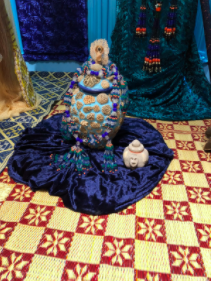 Olocun- god/goddess of deep water
Olocun- god/goddess of deep water
- Tureen
- The main color of the tureen is a shade of light blue with some dark blue accents on the top, the tureen has coral embedded all around the outer part of the tureen. The tureen is a symbol of the god, it’s where they live on the altar.
- Beaded necklace with tassels, mazo
- Wrapped around the tureen is a beaded necklace of sorts, it is made up of orange, green, various shades of blue, and clear beads. The necklace is another way to represent the god and create more of a presence of the god on the altar, the necklaces are also used in the initiation of a person and the introduction of that god to the collection of gods in a person’s head.
- Small jar, Tinajita
- On the ground next to the tureen is a tinajita made of cement, with cowries, and other sea shells embedded into the sides of the jar. As well as various shells a cement face is on the outside of the jar facing outwards. The jar usually is like a power pocket, containing objects of the gods and is usually found inside the tureen but this one was thought to be too beautiful to hide.
- http://sacredart.caaar.duke.edu/artifacts/1535#
- Dark blue fabric
- The tureen and the other objects associated with the mini altar for Olocun are all places on top of a dark blue velvet material, it is used so the the god is not directly on the ground and it is blue because that is the color the represents Olocun.
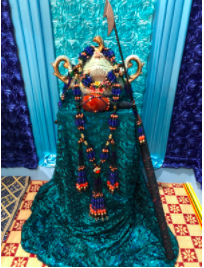
Inle- god of healing and an aquatic hunter
http://sacredart.caaar.duke.edu/artifacts/1505#
- Tureen
- The tureen is ceramic and mint green, it is accented with gold on the handles and with some small designs, the tureen also is painted with flowers. The tureen is a symbol of the god, it’s where they live on the altar.
- Beaded necklace with tassels, mazo
- The necklace is made up of blue, green, orange, black, gold, and small metal beads made to look like fish, the necklace has long tassels coming off of the main strand. The necklace is another way to represent the god and create more of a presence of the god on the altar, the necklaces are also used in the initiation of a person and the introduction of that god to the collection of gods in a person’s head.
- Harpoon
- The harpoon is made of metal but the lower part of the staff where you would hold onto it when you were using it is beaded, the beads are the same same colors as those on the necklace because those are the colors that are used to represent Inle. The harpoon is on the altar because Inle is both the god of healing but he is also an aquatic hunter, so the harpoon represents this side of him.
- Maraca
- The maraca is made of wood but it has beads both on the handle as well as wrapped around the head of the maraca, the beads are the same color as those that are found on both the harpoon and the necklace and they represent Inle. The maraca is used to call the god down into the tureen and to the altar so that they can better hear and respond the the prayers of the worshiper.
- Patterned blue and green fabric
- Inle and all that is associated with the altar are placed on the fabric as it represents the god because of the colors in the fabric are the same that represent the god.
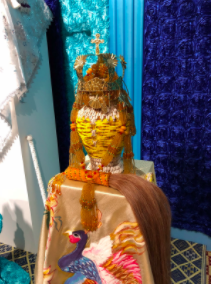
Ochún- goddess of rivers
- Tureen
- http://sacredart.caaar.duke.edu/artifacts/2553
- The tureen to represent Ochún is made of yellow, both opaque, and slightly transparent in color, orange, and green beads, as well as the beads the tureen also has many cowries that decorate the upper and lower part of the tureen with some silver beads hanging down at some of the cowries. The tureen is a symbol of the god, it’s where they live on the altar.
- Oars
- On either side of the altar there are two beaded oars, each decorated with the same colored beads and cowries. The oars are the tools of Ochún which is why they are on the altar.
- Fly whisk
- http://sacredart.caaar.duke.edu/artifacts/1342#
- The fly whisk is made of horsehair, the color being that of a dirty blonde, almost yellow in color, with the handle having beads similar to that of the Tureen, but while the tureen has mainly opaque yellow beads the handle on the fly whisk uses more transparent yellow beads.
- Beaded necklace with tassels, mazo
- The necklace is made up of primarily transparent yellow beads with other green, yellow, and red beads. Each of the tassels hang down off of the main strand of beads. The necklace is another way to represent the god and create more of a presence of the god on the altar, the necklaces are also used in the initiation of a person and the introduction of that god to the collection of gods in a person’s head.
- Crown
- http://sacredart.caaar.duke.edu/artifacts/1285#
- The altar crown looks to be gold in coloring, in the shape of a traditional European crown, at the top of the crown there is a cross, with different ornaments that decorate the main part of the crown. Hanging from the crown though are various metal objects that are made to represent both Ochún and the other gods/goddess that she is allies with. The crown is an important part of the altar Ochún is considered royalty.
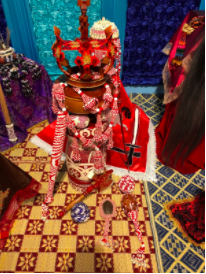
Chango
Crown: This is a cedar crown for chango and has 6, his number, pieces holding up the platform and the figure above. The figure is holding an axe which has a red stone in the middle. This is to show the destructive power of chango.
Tureen: I would like to know the difference of this tureen compared to the tureen in the back which also represents the back.
Rattle (turtle) 1: This is a small rattle that has a turtle shell that is keeping everything inside. There are cowries inside that would produce the noise if shaken. It is covered in the same elegant design of red and white intertwined together like the rest of the area.
Maraca: This is for chango as well based on the color of red and white. The sound when shaken is supposed to emulate a thunder strike and the justice that it represents. At the end, there are 6 strings of cowries which is chango’s number.
Red/ Blue urn: These two urns were used to represent the importance of the twins. Twins are very important in the santeria culture and these urns should be treated as you would treat a person.
Baseball bat: The bat is wrapped around in beads that repeat in a pattern of 6. 6 red beads then 6 white beads which is the number of chango. At the end of the bat, there are 6 strings of beads.
Sword and axe: These are grouped together because they show the power of Chango. He is a strong, hot headed deity who did things quick and with intensity.
Two objects: I want to know what these two hidden objects are and why they seem to be kept away and camouflaged within the stand.
Beaded rope: There is a thick beaded rope that surrounds the stand and keeps things together. There are many forms of the number 6 in the rope itself relating to chango along with the red and white color.
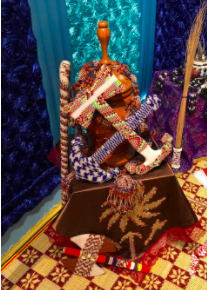
Altar for Agallu
Combined axe and Anchor for Agallu and Yemaya:
sacredart.caaar.duke.edu/artifacts/1267
The Axe is symbolic for Agallu and the Anchor for Yemaya. The anchor is symbolic of Yemaya as it is both metaphoric and literal in that she is the goddess of the sea and an anchor would make logical sense but in the metaphorical sense it describes the woman being the anchor of the family and a mother being a constant in the family always keeping the family in place. The axe is representative of Agallu being the lord of the Volcano because of his close association to Chango due to both of them being uncontrolled forces of nature. Agallu’s colors are white and brown. The reason why the two items are combined as one is because it is symbolic of the item owner’s divine mother and father.
Beaded cane for Agallu: Agallu is considered to be the Orisha of the earth in Santeria and he uses his cane to help him walk and traverse obstacles when he is travelling. Also, due to being born to Obatala that makes him one of the more elderly Orishas and he needs his cane so he can move. He is also considered to be associated with not only volcanos but also earthquakes. He unleashes the fury of the earth shaking it to its core if humankind has been disrespecting the earth.
http://sacredart.caaar.duke.edu/artifacts/1258
Wooden Urn: The wooden urn is Agallu’s. The urn must be activated by having something placed inside of it in order to unlock the altar’s ase.
http://sacredart.caaar.duke.edu/artifacts/1295
Axe: The axe is associated with Agallu due to his association with Chango and the concept of natural disaster and the powerful force of nature.
http://sacredart.caaar.duke.edu/artifacts/1322
Bunched necklace (beads on urn): The beaded neklace is placed over the urn and is stiff like a collar. The colors of the beads on the necklace are brown, red, white, and clear the necklace is primarily brown and white which are the Agallu’s colors.
http://sacredart.caaar.duke.edu/artifacts/1423
Pano for Agallu: Draped over the altar platform with the urn on top of it. The brown color is Agallu’s primary color. The cane, axe, and arrow on the cloth represent Agallu’s invention of tools and those were the three first tools that he made. He made a total of nine which as a result is his sacred number.
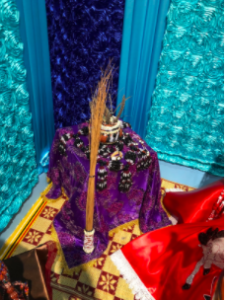
Babalu Aye
Broom: west african style broom, associated with San Lazaro as a means of curing disease. The handle of the broom is decorated in cowrie shells, as well as brown, lavender, and white colored beads.
Beaded Necklace: similar to the other altars, this one has a scrunchy bead necklace, it’s colors are black, white, and brown.
Bracelet: nothing found http://sacredart.caaar.duke.edu/artifacts?tid=396#
Beaded Vessel Altar: Altar to San Lazaro or Babalu Aye (same orissa). Decorated cowrie shells around the lip and beads of brown, lavender, and black covering the majority of it. Black and copper glass marbles ring around it, and feathers stick out of the top. http://sacredart.caaar.duke.edu/artifacts?tid=396#

Oricha Oco
Red and white Pillar- the red and white pillar represent the colors of Oco. Red and white are the colors used while building the shrine.
Silver figurine if farmer and bulls- Oricha Oco is the god of agriculture. His sacred number is 2 or 7. This is represented with the 2 bulls on the altar.
Root vegetables- There are two root vegetables in the altar. They are normally painted white and red.
Collar de Mazo- The colors while used in the necklace are not red and white. The colors used in the necklace are supposed to be purple and light pink. It is most represtented in smaller versions called eleski.
Hide cloth- A cloth is draped over the top of the altar. It looks like it is made of animal hide. The animal hide represents agriculture.
Wooden stand- the whole altar sits on top of a wooden stand. This could represent fertility of the land.
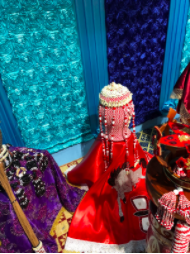
Bárbara
Tureen: Sheet: This kerchief is vibrant in color and in the glitter that brings out the horse and weapons. The sheet around the horse is not an eye catcher. It does not take attention away from the tureen on top but adds to it. Chango, being the deity of fire and lightning, the red color fits his personality and his power.
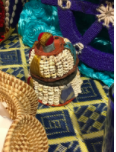
Ori
Vessel- Between the candles and at the base of the altar is a white beaded vessel. It is the spirit in which you are born
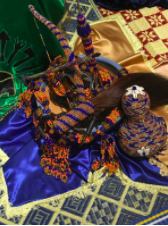
Altar to Ochosi: god of Justice and the hunt:
Bow: the bow is one of Ochosi’s many tools. He uses many different kinds of tools weapons and is often time associated with Ogun who is the maker of tools. This association is shown by the altars being next to one another and the similarity of the items displayed on each altar (cast metal)
Fly whisk: the fly whisk is very prominent. It covers half of the top of the bowl altar
Urn:
Collar:http://sacredart.caaar.duke.edu/artifacts/1420: The beaded necklace around the altar has the same basic colors as the rest of the altar which are his colors. There are 7 tassels coming off of the necklace that represent ochosi number. It keeps the altar togther.
Lance: http://sacredart.caaar.duke.edu/artifacts/1411: The lance is also one of Ochosi many tools. The handle is made of the colors blue, purple, orange and yellow to coincide with the rest of the altar. Ochosi uses this object to hunt for justice and the truth.
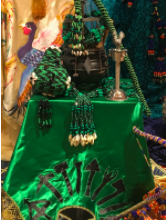
Oggun god of war and war and iron
Garbato – resting on the top of the altar is a beaded Garbato. The beads are black and green and make up a staggered pattern.
Iron Cauldron- an iron cauldron is the centerpiece of the altar. It is made of iron. Within the cauldron are all the symbols of Oggun. It contains an anvil, knife, hammer, nail, bow, shovel, rake, hoe, iron, and pick
Collar de Mazo- A green and black collar is draped along the front of the altar. The necklace has bunches on it that drape along the altar.
Green Beaded vase- Next to the altar is a green beaded vase. It is made of green and black beads that make a staggering pattern. The front of the necklace has white beads at the end of the tassels.
Osun the sentinel- There a relic that represents Osun on the top of the altar. It is made of a metallic material. The top of the relic has a rooster. The sentinel guard the worshippers head.
Pano- The green Pano covers most of the altar. There is the symbols of the cauldron and the items inside the cauldron. The symbols represent iron tools.
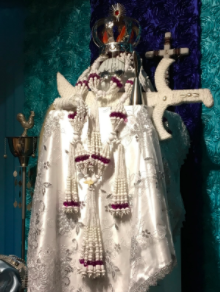
Obatala
Sword: Used to symbolize Obatalá, white beads cover the whole thing with shells set in the handle. White is his color, showing purity, protection from evil, and all the colors in one.
http://sacredart.caaar.duke.edu/artifacts?tid=396#
Fly Whisk: 8 tassels hang as his number is 8.
Bell: A shiny silver bell with the image of a feather inscribed as the handle.The feather represents the symbolism of the dove for Obatalá. When rung it makes a sound specific to Obatalá
http://sacredart.caaar.duke.edu/artifacts?tid=396#
Altar:
Crown: Made out of metal and feathers. A sun motiff sits on top of it as Obatalá is the God of the Sky. Ocha Criñá is a specific “road” (camino), or avatar, of Obatalá.
http://sacredart.caaar.duke.edu/artifacts?tid=396#
 Oya
Oya
-
- Horse-tail whip
- There is a black horsetail whip with a beaded handle in the front of the altar. The handle is maroon in color with small splashes of other colors, yellow, blue, white, and red. This whip represents Oya’s royalty among other Orisha.
- Horse-tail whip
-
- Crown
- There is a copper crown that represent the Orisha’s royalty. The copper is Oya’s metal, and the charms that dangle off the crown are masks and lighting bolts, all common symbols for the Orisha.
- Soup tureen
- A cream-colored soup tureen with birds as handles and decorated the top sits in the center of the altar. It holds up a lot of the other object on the altar and embodies the Orisha. Tureens hold important sacred objects belonging to the altar maker’s Orisha, these include stones and tools of the Orisha. The tureen also represents the head of the altar, it is what embodies the Orisha.
- Wooden sword
- This wooden sword is wrapped in a beaded cover with a beaded handle decorated with a mask. The colors of these beads are orange, green, red, yellow, black, blue, and purple. The sword represents Oya and her warrior side.
- Catholic saint cloth
- This cloth represents the Orisha in two ways. It is her main color, maroon, and the catholic saint depicted on the cloth represents Oya.
- Beaded necklace
- There is one beaded necklace wrapped around the tureen. The beads represent Oya’s colors, maroon, orange, yellow, brown, red, blue and green. The necklace is wrapped around the tureen as it would be wrapped around one’s neck because the tureen represents the head.
- Crown
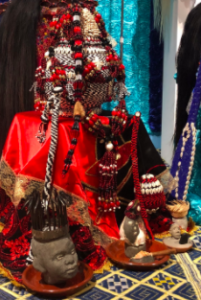
Elaggua
- “Calabash(Guiro) of Eleggua”
- This soup tureen is made up of black and white beads, along with three small sections of black and red beads. The colors represent the Orisha and the three red and black sections pay tribute to the Orisha’s number, three. Cowry shells make up the lid of the tureen and also decorate the body of the object, these shells are popular objects used to represent Eleggua.
- Beaded necklace
- There is one beaded necklace made up of black, red, gold, and whites beads. These colors symbolize the Orisha. The necklace would have been used in ceremonial purposes when the Orisha possess’ an individual, and is stored on the tureen until it is used again.
- “Garabato”
- There are three garabatos on Eleggua’s altar, one is decorated with black and white beads while the other is decorated with red and white beads, the last one has a mixture of red, black, and silver, in the pattern of three. The last garabato is different from the others because one small section contains a spot with fur, this is not like any of the other objects on the altar. There are cowry shells on the top of each garabato and beads dangling off the edge. These objects are a popular sugar cane harvesting tool and is a symbol of the Orisha. This object is used to symbolize the Orisha.
- “Pano for Eleggua”
- This is a red and black cloth that represent the Orisha Eleggua. The colors are his represented colors and the with its features made out of cowry shells symbolizes the Orisha’s face.
- Image of Eleggua
- This image of Eleggua is represented with a concrete head with eyes made up of cowry shells. On his head, there is a “hook iron crown.” This is another representation of the Orisha, and can be used to feed and care for Eleggua so he stays happy.
- Concrete shell
- There is a conch shell that is half concrete. This fits with the style of the concrete heads of Eleggua and is simply decoration.
- Cigar
- There is a cigar lying next the the concrete shell and another concrete face of Eleggua. This cigar keeps the Orisha happy since it is one of his favorite.
- “Cement eleggua head in small conch shell #12”
- This cement head takes up the hollow side of a conch shell; it has all its features, eyes, mouth, and nose, made up of cowry shells. On top of Eleggua’s head is a beaded crown. This crown represents the Orisha’s colors, red and black, along with his number, three. The number is represented through a pattern with cowry shells. This crown is meant to be worn by the Orisha and that is why it placed on the concrete representation of Eleggua. This objects embodies the spirit of the Orisha.
- Concrete head and rock
- There is a concrete platform with a head coming out along with a rock. The head has a lot of details, more than the other concrete heads and is staring at the rock in front of him. This object is another representation of Eleggua and meant to honor him.
- “Cement Eleggua #3”
- This cement head of Eleggua differs from the rest because instead of a crown its head has a straw hat. The features are still made out of cowry shells and this object is another representation of the Orisha.
- Hanging beaded sphere
- Hanging from one of the garabatos is a beaded sphere. It is made up of red and black beads and cowry shells. The shell pattern is another representation of the Orisha’s number.
Sources
Brown, David. 1996. “Altar Making and Gift Exchange” in Santeria Aesthetics In contemporary Latin American Art. Edited by Arturo Lindsay, Smithsonian Institution Press.
Clark, Mary Ann. 1999. “Asho Orisha (Clothing of the Orisha): Material Culture As Religious Expression in Santeria” 220-224. University of Michigan microfilm. https://scholarship.rice.edu/bitstream/handle/1911/19365/9928518.PDF?sequence=1&isAllowed=y